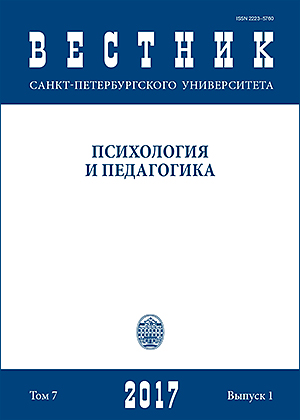Воплощенное познание как современный тренд развития когнитивной психологии
DOI:
https://doi.org/10.21638/11701/spbu16.2017.102Аннотация
В статье описывается один из основных трендов развития когнитивной психологии — теоретические модели, связанные с исследованиями воплощенного познания (Embodied cognition). Фиксируются недостатки классического символьного подхода — первого теоретического направления, сложившегося в когнитивной психологии в 1950–70-е гг. Выделяются основные направления подхода, связанного с воплощенным познанием: укорененное познание, энактивизм, феноменологический подход, неоэкологический подход, теория динамических систем. Подробно характеризуются два первых.
Ключевые слова:
воплощенное познание, (Embodied cognition), воплощенность, когнитивная психология, укорененное познание, энактивизм, теория перцептивных символов, индексная гипотеза
Скачивания
Библиографические ссылки
target=”_blank”> http:// doi.org/10.1177/1745691613498098
target=”_blank”> http://doi.org/10.1111/j.1756-8765.2010.01115.x
нова, М. В. Фаликман. М.: Ломоносовъ, 2011. 383 p.
target=”_blank”> http://doi.org/10.1006/jmla.2000.2705
target="_blank">https://doi.org/10.3389/fpsyg.2013.00330
Massachusetts: The MIT Press, 2013. 206 p. http://doi.org/10.7551/mitpress/9780262018548.001.0001”
target=”_blank”> http://doi.org/10.7551/mitpress/9780262018548.001.0001
http://doi.org/10.1177/1745691613498098”
target=”_blank”> http://doi.org/10.1177/1745691613498098
http://doi.org/10.3758/BF03196322”
target=”_blank”> http://doi.org/10.3758/BF03196322
http://doi.org/10.1111/j.1756-8765.2010.01115.x”
target=”_blank”> http://doi.org/10.1111/j.1756-8765.2010.01115.x
target=”_blank”> http://doi.org/10.1006/jmla.2000.2714
target=”_blank”> http://doi.org/10.1017/S0140525X99252144
target=”_blank”> http://doi.org/10.1006/jmla.2000.2705
target=”_blank”> http://doi.org/10.1207/s15327868ms1401_6
motor representations in semantic sensibility judgments. Journal of Memory and Language, 1989, no. 28 (1), pp. 56–77.
stimulation of the tongue in the congenitally blind. Brain, 2005, no. 128 (3), pp. 606–614.
system: localisation and object recognition with “The Voice”. Perception, 2007, no. 36 (3), pp. 416–430.
target=”_blank”http://doi.org/10.3389/fpsyg.2013.00330
Understanding the Feel of Consciousness”. Review of Philosophy and Psychology, 2012, no. 3 (1), pp. 89–108.
target=”_blank”> http://doi.org/10.7551/mitpress/9780262018548.001.0001
Загрузки
Опубликован
Как цитировать
Выпуск
Раздел
Лицензия
Статьи журнала «Вестник Санкт-Петербургского университета. Психология» находятся в открытом доступе и распространяются в соответствии с условиями Лицензионного Договора с Санкт-Петербургским государственным университетом, который бесплатно предоставляет авторам неограниченное распространение и самостоятельное архивирование.




